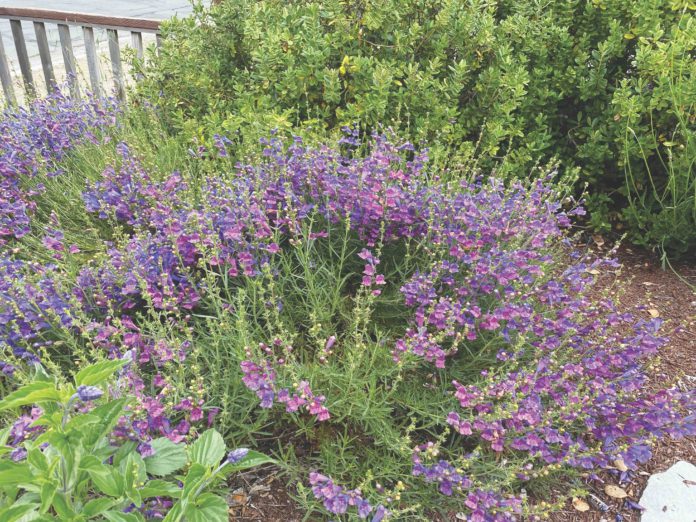
It sure has been a hot summer. Starting back in May when we had a couple heat waves, the hot weather just hasn’t let up and with the changing climate we can count on more of the same. I’ve had to adjust what I used to consider tough plants for hot, sunny spots, but I haven’t given up. My palette is just smaller for un-thirsty plants for birds and butterflies. I want to conserve water and also enjoy my winged friends.
California native plants are always a good choice for difficult areas. In addition to workhorse shrubs like manzanita, toyon, ceanothus, coffeeberry, garrya, Catalina cherry, bush lupine and Pacific wax myrtle, showy natives like salvia, buckwheat, California fuchsia, monardella, wallflower, yarrow, lavatera, penstemon and sticky monkey flower are high on my list.
Everyone should have some lavender in their garden. Hummingbirds and butterflies both favor this plant and there are new introductions every year from growers. There are dozens of new varieties to choose from. Hidcote Superior forms a bushy compact mound with sensational purple flowers in early summer.
Or you might try Royal Purple, Betty’s Blue, Violet Intrigue, Sachet or Royal Velvet. Goodwin Creek is an old stand-by that blooms from spring to late fall with deep violet blue flowers. For midsummer bloom, plant Grosso, which is a widely planted commercial variety in France and Italy. It’s possibly the most fragrant lavender of all. Spanish lavender blooms spring into summer if sheared. By planting an assortment of lavenders, you can have a succession of flowers throughout the season.
Penstemon also lure hummingbirds and butterflies to the garden. They come in a wide range of colors and varieties from native species to garden hybrids. I especially like the red flowers of Garnet and the blossoms of the native Blue Bedder.
Another long blooming, tough plant is achillea Moonshine. Butterflies love to alight on the yellow flat landing pads of this yarrow. The dense flower clusters make good cut flowers and the gray-green foliage blends with all colors in the garden. Yarrow needs only routine care once established. They can take some watering although they endure drought once established. Cut them back after bloom and divide when clumps get crowded.
There are so many salvias to choose from and all are great additions to a tough-love garden. Autumn sage blooms summer through fall in colors ranging from deep purple through true red to rose, pink and white. Purple Pastel is especially beautiful covering 3-4 foot plants with blossoms filled with nectar for hummingbirds and butterflies.
Those who seek true blue flowers for their gardens might try planting salvia chamaedryoides. This elegant front-of-the-border plant has silvery foliage which sets off the brilliant blue flowers. Heaviest bloom is in late spring and fall. Deadheading encourages re-bloom. This salvia is drought tolerant but blooms longer and better with a little occasional summer water.
More un-thirsty bloomers that attract either hummingbirds, butterflies or both and are easy to grow are gaura, coreopsis and homestead purple verbena. Asters, Russian sage, black-eyed Susan, bee balm, mums, autumn joy sedum and cosmos are also on the menu of our winged friends. Many of these also make good cut flowers.
Plant some new water efficient plants for color that attract hummingbirds and butterflies. Afterwards spread fresh wood chips or compost to mulch the soil. This insulates and protects shallow roots from the heat of the summer sun. While keeping the soil cool, mulch slows the evaporations of water from the soil so it stays moist longer.
Wherever you garden, to provide food, nectar or berries for our winged friends be sure you have some flowering perennials.
Jan Nelson, a landscape designer and California-certified nursery professional, will answer questions about gardening in the Santa Cruz Mountains. Email her at ja******@*ol.com, or visit jannelsonlandscapedesign.com












